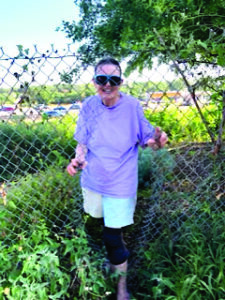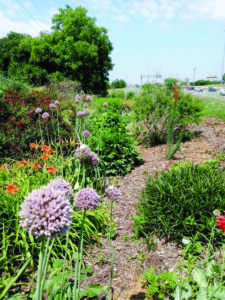By C.W. Smith
Just behind the house Lorlee Bartos bought in 1980 stretched an alley, a narrow strip of earth, a six-foot chain-link fence and a wide swath of weed-choked public land sloping down to the asphalt of eastbound I-30. She planted roses along her side of the fence, and soon their long stems and blooms poked through, but then “mowers whacked them down,” she said.

Photos by C.W. Smith
Bartos figured if she crossed over into that big berm “and made something that looked enough like a garden,” the mowers would leave it alone. She started with a patch of day lilies and irises. “I also had enough lettuce for a hotel salad bar.” That seemed to work. But to get there, Bartos had to go to the end of her block and around the fence and back to her workspace, so “I bought myself a pair of bolt cutters” and boldly chewed a hole in the fence big enough to step through.
Wasn’t she afraid of being arrested for vandalism? It was, Bartos says, “a gamble.” At some point after that, someone with the city told her they knew about the hole, but they have never made an issue of it.
Then came a water line that went from her house, under the dirt in the alley, and into that colonized space. Maybe 200 ft. of garden hose. Bartos became, in her own words, “a guerrilla gardener” who plants on someone else’s land. Today, decades later, she tends 4,000 square feet of guerrilla garden with phlox, lantana, Turk’s Cap, Copper Canyon daisies, canna lilies, garlic, rattlesnake master, asparagus, rudbeckia fulgida, sage — and dozens more that now draw bees and butterflies. There are persimmon and plum trees, and a peach tree that grew out of a compost pile. People give her plants. Bartos tells this story about her poppy plants: “When I first moved into my neighborhood I … met a woman who had a reputation for being quite crotchety. She would be out early in the morning in her garden before it got too hot. We worked up to conversations about gardening. She gifted me with seeds … and shared that she had gotten the seeds in 1917 after her husband came back from the war.”
Bartos also admits to sneaking cuttings in the dead of night, and she buys plants and inherits them. She also gives them out to friends and neighbors. She talked a landscape company working on the block into giving her their mulch, and she has toted bags of leaves neighbors have left on the curb home to enrich her plot.
She says she has “the Bartos green thumb,” but there’s no secret — just “persistence.” Bartos’ Minnesota father was a farmer, and her grandfather, who lived next to a train track, put a garden on railroad land. Her Aunt Annie “gardened at age 90” (Bartos is 76), “and she carried buckets of water” to her plants. Another grandmother always gardened “barefoot.” Like them, she does her work herself, aside from paid assistance from students at the nearby Dallas Theological Seminary from time to time.
And, before Bartos retired, the work had to be done around her busy professional life. She worked for 17 years as a legal secretary for a Dallas law firm but, at the same time, during election seasons, she was a political consultant. Throughout the years, Bartos advised the campaigns of many familiar candidates, such as Dallas’s first female mayor Annette Strauss and many city council candidates — Lee Simpson, Craig McDaniel, Lori Palmer, Chris Luna and Harriet Miers are some. She has also sat on several city boards, such as the Board of Adjustment, License and Permit Appeal Board, Community Development board, and she chaired the Urban Rehabilitation Standards Board.
Bartos is not afraid to use the knowledge gained about how the city works. The person who cut a hole in that fence is a bit of an activist, and she brought streetlights and trees to the parkway on her street, and, when the city had a federal grant for neighborhood improvement, Bartos knocked on doors up and down her street and managed to get a dozen neighbors funding for repairs.
But her biggest job is yet to come and may be out of reach. Bartos has attended town hall meetings for many years about TXDOT’s plans to widen I-30 into at least 16 lanes, work that would bulldoze every inch of her garden and the present protective shoulder. At the latest recent meeting, sketches were unveiled. “I’ve been telling them for years that if your question is ‘how do you move cars,’ then lanes are the answer. But if your question is ‘how do you move people,’ there are other solutions.” Nonetheless, TXDOT will release bids in 2027 for the project. Bartos is not worried that her guerrilla garden will be ploughed under anytime soon, but it’s sad to consider that as an inevitable event.

In the meantime, Bartos does yoga and water aerobics, attends a healthy cooking class and many cultural events. She also belongs to a group of poets who meet monthly to share their work. Bartos wrote this in honor of her gardening grandmother:
Grandma Klimek
She unlaced her black heeled shoes,
took them off and
lined them up perfectly beside her bed.
It was the kind of footwear
worn by grandmothers in the 50s
and nuns when they still wore habits
She went out the side screen door —
used only when the weather was finally warm,
past the small coop with the mother duck and her babies,
to her garden thriving in the afternoon sun
with its abundant vegetables —
and one riotous row of zinnias.
The sun strong behind her
The corn tall and rustling
She stands there in her garden
The black soil warm
under her bunioned bare feet,
the ropey, varicose veins visible below her dress
and old-fashioned bib apron.
Women of that age and time
never wore pants or garden clogs.
